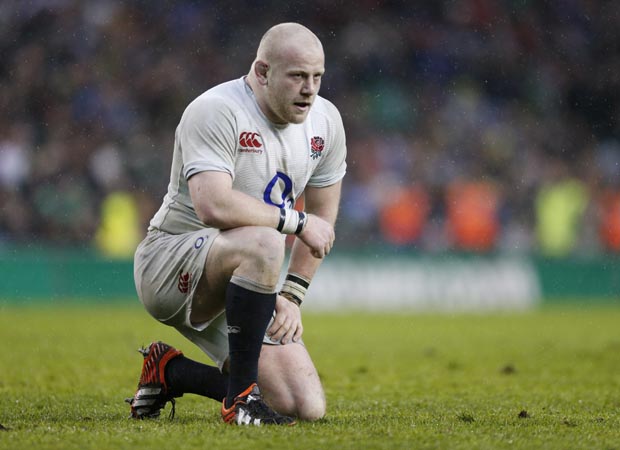
 Where have all the tight-heads gone? That was the question giving England fans pause for thought this week as they contemplated facing the Irish with Dan Cole ruled out with a neck injury, his replacement David Wilson only a week into his comeback after being on the sidelines for three months with a calf injury, and bench cover Henry Thomas a 22-year-old novice with only three minutes of Test experience (against Scotland).
Where have all the tight-heads gone? That was the question giving England fans pause for thought this week as they contemplated facing the Irish with Dan Cole ruled out with a neck injury, his replacement David Wilson only a week into his comeback after being on the sidelines for three months with a calf injury, and bench cover Henry Thomas a 22-year-old novice with only three minutes of Test experience (against Scotland).
Win or lose, it was is not what England wanted in the key scrummaging position on the pitch going into their defining fixture of the Six Nations. Doubly so with the resurgent Irish loose-head Cian Healy primed to cause trouble.
However, although England’s tight-head stocks look dangerously depleted at international level, they are not in a minority of one. Whether it’s England, France, Wales, Ireland or Scotland – or even New Zealand and South Africa – hardly anyone is three deep where Test-quality No.3s are concerned.
There are plenty of people playing tight-head at club level, but, when it comes to the professional game, and the summit which is Test rugby, there are very few equipped to do the job – either physically or mentally.
With the force of five opposition forwards being channelled down the tight-head’s side of the scrum when defending his side’s put-in, he has to deal with more than 1,000kg of weight bearing down, where an ordinary man could not handle more than 100kg without his neck or back buckling. Not only that, but he is immediately facing two assailants with the opposing hooker attacking under his left shoulder, and the loose-head under his right.
In the face of the assault the tight-head must remain the immoveable object, because if he does not his side’s scrum ball will either not be worth having, or they will concede a steam of penalties. Phil Keith-Roach, the renowned scrum specialist who was part of England’s 2003 World Cup winning coaching team, says that the role is even more crucial under the new scrum laws – and even more fraught – because they have empowered the loose-head.
“There is no more exposed position in the game. There is no position in which, if you are not good enough, you can be so embarrassed in plain sight. What many people have yet to recognise is that the new laws have exposed the tight-head even more than he was before – and that the boys who have gained the most are the loose-heads opposite them.”
Keith-Roach continues: “Even experienced Test tight-heads like Adam Jones and Cole have struggled with the new engagement. This is mainly because the tight-head can no longer use the rolling hit to drive through the loose-head. The requirement now is that he has to be square and static before the put in, keeping his chest and right shoulder down while, at the same time keeping his bind up on the shirt, not on the arm.”
He argues that this has set up the traditional strongman of the scrum to be attacked by the loose-head, who tries to get underneath him like a coiled spring. The tight-head has always had to cope with the pressure from the loose-head, but, with the hit-engagement taken out of the equation, it is more difficult for him to unbalance them.
On top of that, on the tight-head’s own put-in, his hooker will not initially be pushing with him, but having to strike for the ball instead, meaning that with the hooker momentarily on one leg he has to absorb even more pressure.
To make the job even more difficult the tight-head is under constant attack according to Keith-Roach: “The No.3 is under attack at all times because the new ploy at the scrum is to get your loose-head going forward, and your tight-head to follow, often resulting in a penalty. There are no rest scrums, no breather, as you will be targeted on your own put in as well as on the opposition’s.”
He adds, “Under the old law Adam Jones would just hit and try to roll forward with the benefit of the force behind him. With the old ‘hit-and-go’ a tight-head could go a bit upwards, sideways, or down – but now he cannot do that.”
It puts a huge amount of heat on the tight-head, and it is why good ones are worth their weight in gold and among the best paid players in the world.
Having played during the cross-over between the amateur and pro games Victor Ubogu may have been paid less than his modern counterparts, but he has a wealth of knowledge from the era where tight-heads like him had to hold the world – and hookers had to strike for the ball.
Having worn the England No.3 shirt with distinction from 1992 to 1999, including as part of the 1995 Grand Slam-winning side, and helped Bath to become the first British or Irish side to win the Heineken Cup as the anchor in their goal-line stand against Brive in 1998, Ubogu says too much is expected too soon of young tight-heads.
“The main issue is the guys are young. They are hitting very hard and the body is not quite mature enough at 21 or 22. Back in the day you were not considered as an international prop until you were 28. The nature of the position is that you need that time to develop the specific muscles and ligament strength – and that’s why they collect niggly injuries which build up.”
He adds, “ You will not get the strength a tight-head needs to hold a strong scrummaging position from pumping iron, you get it from scrummaging practice, either eight on eight or on scrum machines. You have to be in the right body position or you are stuffed – and too often these days they are not in the right position.”
Ubogu’s advice to tight-heads struggling with the new (old) laws? “You have to try to beat the loose-head to the punch when the engagement is called so that you set in the position you want. That means being dynamic in getting across the line, and working in tandem and being tight with your hooker.”
The change to the engagement law gets the thumbs up from Ubogu: “I’m pleased to see the scrum going back to the way it was – it makes it more of a contest, and it has emphasises that hooking requires skill and durability. Inevitably, when you have hookers who have moved across from centre, they will find it uncomfortable.”
Keith-Roach offers further insight into the scrummaging mechanics of an effective tight-head. “Under the new engagement the props who are making it work are those who make solid contact and maintain a good body position. This helps a tight-head to keep pressure on the opposition by being an effective conductor for the force transmitted through him from behind. To do this he has to be confident and patient enough to wait for the force rather than trying to do it all on his own, because the ‘hit-and-chase’ will mean he loses a stable position.”
He notes, “The key factor is for the tight-head to have the core strength to be able to bear down on the loose-head and transmit the forward drive while keeping his back ramrod straight. It helps if he is a heavy, powerful man with immense durability.”
One factor preventing young tight-heads getting enough time on the pitch is that for many clubs in England and France every league game counts, while there is also no room for the Irish, Welsh or Scots, to experiment with props in a competition as fierce as the Heineken Cup.
Keith-Roach says, “There is no gestation period at tight-head. The reality is that clubs facing promotion and relegation in competitive leagues need tight-heads to be good enough instantaneously. Whereas a forwards coach can get away with a young lock who isn’t a good scrummager, at tight-head he cannot. You cannot experiment in the same way they do in Super Rugby. In the Southern Hemisphere they can take a chance on a young tight-head more readily because in a competition without relegation you can afford to drop the occasional game.”
His words are borne out by Gloucester’s scrum shortcomings this season. Their campaign has been disrupted because their two young English tight-heads – Rupert Harden and Shaun Knight – were not quite ready. As a result an exciting backline sometimes cannot get into the game, and now they’ve bought in Sila Puafisi pending the arrival of John Afoa from Ulster over the summer.
Keith-Roach comments, “Overseas props are only necessary when your homegrown boys are not yet ready. That explains why the Irish provinces, for instance, are prepared to pay for good, experienced tight-heads from the Southern Hemisphere with Test credentials such as Ulster’s Afoa (New Zealand) and Munster’s BJ Botha (South Africa). They have been crucial to the competitiveness of those sides in Europe.”
At the other end of the scale are Harlequins, where two of their three English tight-heads are young props who are developing well.
After a shaky start to the season Tim Collier has really come on, and the Quins scrum has not fallen apart despite the departure of James Johnston. Kyle Sinckler is promising too, and they also have Paul Doran-Jones, although he might had suffered from being promoted too quickly by England a few seasons ago.
Newcastle also have two tight-heads who might be able to stake a claim with Kieran Brookes backed up by the promising Scott Wilson – even if, judging by his accent, the Melrose-born Wilson should be playing for Scotland.
Jake Cooper-Wooley at Wasps is another who has made headway. However, few teams have as much tight-head strength as they do at loose-head – and, to thin out the candidates further, half of the starting No.3s in the Premiership are Pacific Islanders, like James Johnston (Saracens), or Antipodeans like Salesi Ma’afu (Northampton).
For instance, while England are three deep in Test loose-heads with Joe Marler, Mako Vunipola and Alex Corbisiero (currently injured) – and have promising newcomers like Northampton’s Alex Waller and Exeter’s Ben Moon as back-up – there is no such depth at tight-head.
And yet there is no position where it is so non-negotiable.


Miscellaneous
The Best Rugby Themed Games
Features
OSCAR WILSON






























You must be logged in to post a comment Login